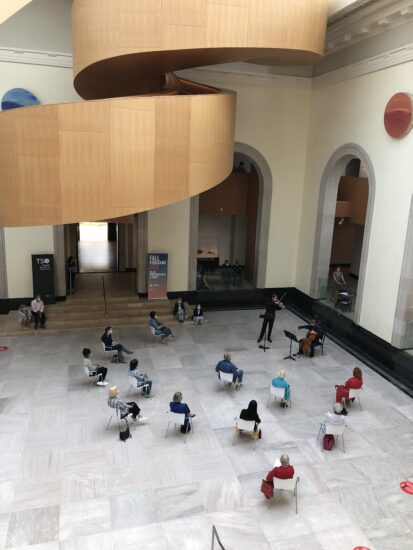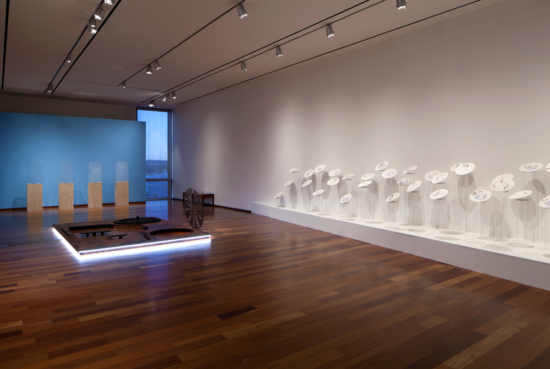This week’s contributing authors are Emily McKibbon and Renée van der Avoird. Emily McKibbon is the Acting Director of the MacLaren Art Centre in Barrie, Ontario. Renée van der Avoird is the Assistant Curator of Canadian Art at the Art Gallery of Ontario, Toronto.
A moderate climate that avoids extreme temperature and RH fluctuations and that excludes daylight and/or filters out ultraviolet and infrared radiation and air pollution provides the appropriate environment for collection preservation.[1]
This article is not about whether museums can (or should) be neutral: they can’t be, they shouldn’t be, and as museum professionals we need to ensure that we wield this power wisely. Instead, our focus is on the lived space within our galleries: the affective environment around the works, how space feels for audiences, how it welcomes some and crowds out others, and how the care and preservation of contemporary art needs to include some discussion of how we hold space for audiences, and not just the artworks on view. While many in the curatorial field have moved past discussions around neutrality as a political conceit, we haven’t yet unpacked how this discourse inflects our conversations around preservation environments: the “moderate climates” that are often chilly, white-walled, and hushed, designed more for artworks than for viewers.
With Covid-19, our galleries and museums have been held in stasis as we consider how to reopen responsibly, zeroing in on pressure points in our buildings (stairwells, elevators, bathrooms, corridors), considering the necessity of programming and outreach, and determining which historical portrait in our collections to photoshop into a surgical mask as we announce our cautious re-openings on social media. With the rush to return to something approaching normalcy, many art spaces are missing the opportunity for change. Our metrics for success, our funding models, the ways in which we work, all will shift. The protests happening throughout Canada and the United States against anti-Black racism and systemic violence highlight how necessary it is to transform our ways of being[2]. Covid-19—which has disproportionately impacted BIPOC and marginalized communities—could be a reset button that creates the conditions for systemic change from within museums. But it can also make the issues in our field much, much worse.
As curators—one at an encyclopedic art museum and the other at a regional public art gallery—both of our institutions reopened in July under different circumstances, with different challenges and imperatives. On July 1, 2020, the Art Gallery of Ontario (AGO) opened to members only on an online-reservation, timed-ticketing basis, with stringent safety protocols in place. As one of the largest art museums in North America, and with an exhibition program helmed by international blockbusters, such as Yayoi Kusama: Infinity Mirrors, we typically draw large numbers of tourists. However, we also focus on our local community.
The gallery occupies a full city block on the Eastern edge of Toronto’s Chinatown, a high-density residential and commercial area within the city’s downtown core. With locals doing their best to isolate at home during the summer heat-wave, the AGO’s vast climate-controlled galleries and wide-open Walker Court could provide a space of solace, comfort, and relief for community members. What are the ethics of safeguarding the building for a select number of members at this crucial moment, when physical space is at such a premium? While opening doors freely to our community is neither feasible nor responsible at this time, questions of equity and access must remain central as we reopen.

Toronto Symphony Orchestra plays in the Art Gallery of Ontario’s Walker Court, September 2020. Photo by Renee van der Avoird
We are functioning now with only a fraction of our staff onsite, and how is this paring-back affecting visitors? While they may revel in the opportunity to view artworks in uncrowded rooms, they are also left without gallery guides, docents, tours, and workshops to encourage them explore and contextualize those artworks. As educational programming is key to access and allyship[3], now is the time to consider alternate modes of connecting with visitors. While the AGO is still wading through these murky waters, it has made drastic changes to its Education program: as of October 2020, all school programs are available online, free of cost. This is one example of how the Gallery can remain accountable to the public, and withhold our responsibility of caring for the communities we serve.
The MacLaren Art Centre is a regional public art museum in Barrie, Ontario, a city 90 minutes north of Toronto with a population of roughly 140,000. The MacLaren, along with the downtown branch of the Barrie Public Library, is one of only two free indoor public spaces in the city centre. Admission is free and has never required ticketing or advance booking; when we reopened on July 2, 2020, we asked that visitors book appointments by phone or email prior to arriving without necessarily having the digital infrastructure to support this practice. We have been asked by public health authorities to gather names and contact information of all visitors to allow for contact tracing, if needed, but pre-booking appointments and gathering personal information does re-introduce significant barriers to access. In previous summers, we’ve often acted as an unofficial cooling space for city residents in the summer, offering gender-neutral bathrooms, a cafe (still closed through Labour Day), and a quiet place to land for our largely local audience. The MacLaren, as a public institution, also has a defibrillator and Naloxone kits[4] onsite with a team that’s trained to use them; while we don’t look to galleries for these life-saving services, a dearth of open public spaces to turn to in a medical crisis has exacerbated the opioid epidemic throughout Canada.[5]

Installation view of Settling in Place: Aylan Couchie, Martha Griffith, Charmaine Lurch, guest curated by Dr. Andrea Fatona, MacLaren Art Centre, Barrie, 2018. Photo: Andre Beneteau
As a small institution with limited resources, we’ve never been able to afford full-time attendants or guards in any of our gallery spaces. By necessity, we’ve had to have difficult conversations with artists about the risks they’re willing to assume when exhibiting here: generally, we don’t exhibit unframed works on paper, fragile sculptures, or any works that might require enhanced security measures. On a good, pre-pandemic day, that means our galleries allow a private engagement with the exhibitions that’s largely free from scrutiny, something that I hope our audience values as much as I do. On a bad day, artworks are touched, children run amok, and in-the-moment questions someone might have about an artwork go unanswered. At this precise moment, I worry that our unmonitored spaces could create the conditions where micro-aggressions against BIPOC and socioeconomically marginalized visitors might flourish. Covid-related anxieties amongst our white and more privileged audiences could likely exacerbate any unexamined racist and classist assumptions they hold. Our current visitor’s policy—which concerns itself mostly with umbrellas, backpacks, and unattended children—will need to be transformed to meet this challenge, with additional training required for frontline staff. That we haven’t considered this necessary prior to Covid is a personal source of shame.
The encyclopedic art museum and the mid-sized regional public art gallery might share similar mandates—bringing art to people, and people to art—but their means of doing so vary widely. The AGO brings in approximately one million visitors per year; the MacLaren, roughly 50,000. During a pandemic, museums offer both relief from anxiety and the very real risk of infection. The means of mitigating the risk of transmission—managing crowd size, timed ticketing, and instituting visitor tracking—are significant barriers to access, particularly when considering those who might need us most at this critical moment. We have spent significant time consulting with public health officials and our internal pandemic response teams—often with no representation from front-line educational and visitor services staff, who bore the brunt of museum layoffs—but we have failed to listen in myriad other ways. We’re not speaking enough to our local communities and, often, the artists whose work goes on our walls and in our galleries.
So what does it mean to hold space in a pandemic? Can we conceive of this pandemic as one crisis in a context of ongoing crises, which include state violence against BIPOC communities, mass gentrification, the opioid epidemic, and increasing socioeconomic inequality? We know that the literal chill of the gallery is felt differently by men than it is by women[6]—studies of indoor air temperatures have shown us how air conditioning is a gendered science—but there are other chills in these privileged spaces as well. The affective chill of uniformed security staff who police our interactions with the artworks on view; etiquette signage which emphasizes what we must not do, not what is possible to do; and the sometimes-incomprehensible language of museum didactics contribute to environments that feel hostile or unwelcoming to many. We would be curious if an institution has ever asked an artist whether they wanted uniformed security stationed alongside one of their works, or if placing a guard in its proximity might be a conceptual or emotional barrier against a true engagement with their work? And what of our Covid precautions, which reduce the amount of interpretive aids, increase scrutiny from museum staff, and require significant planning and pre-booking to access exhibitions?
While ensuring the wellbeing of staff and visitors is paramount, it is also our responsibility to counteract the exacerbation of problems of access and inequality. Limited numbers of visitors, members-only access, online booking, and reduced hours will amplify forms of privilege and barriers that museums have, for many years, been making efforts to break down. A clarifying question might be: for whom are we reopening, and is that the audience that needs us most at this time? Can we widen our mandate to those who live in overcrowded housing developments—often our closest neighbors in the downtown cores we inhabit—and those who have been historically marginalized within our institutions? We have the space, but not always the will, to re-envision ourselves as hyper-local, particularly when our local communities aren’t major donors, spendy tourists, or those with significant cultural capital. Can we take steps towards equity with the same urgency that we’ve employed in our Covid-19 task forces? And what can we carry forward from this experience, knowing that this is a rare opportunity to create transformative change within our troubled field?
[1] CHAPTER 4: MUSEUM COLLECTIONS ENVIRONMENT NPS Museum Handbook, Part I (2016) 4:1 Museum Collections Environment https://www.nps.gov/museum/publications/MHI/MHI.pdf
[2] https://news.artnet.com/art-world/museum-open-letters-activism-1894150
[3] https://www.tandfonline.com/doi/pdf/10.1080/10598650.2017.1306664
[4] Naloxone is an opioid antidote and can reverse the potentially fatal effects of an overdose. Naloxone kits are an important harm-reduction tool and are increasingly carried by organizations and businesses where opiate overdoses are common.
[5] https://www.cbc.ca/news/health/drug-overdoses-covid19-1.5605563
[6] https://www.newyorker.com/tech/annals-of-technology/is-your-thermostat-sexist
